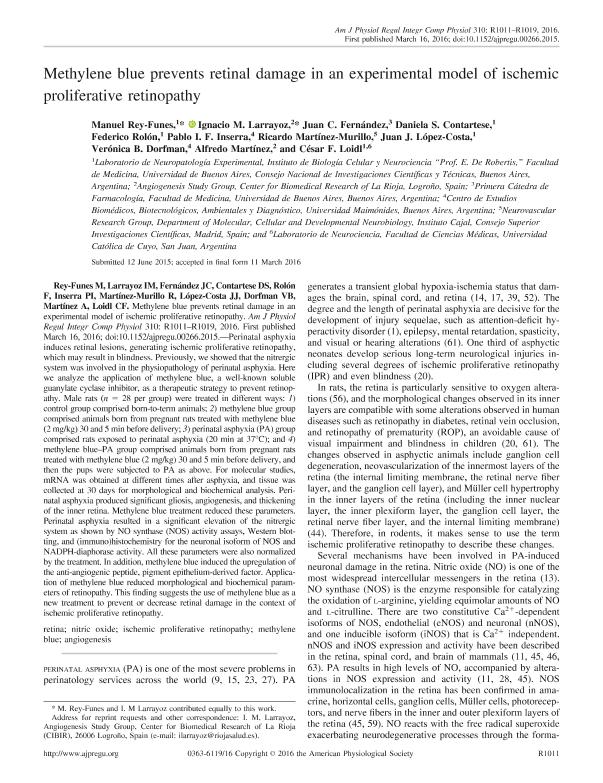Artículo
Methylene blue prevents retinal damage in an experimental model of ischemic proliferative retinopathy
Rey Funes, Manuel; Larráyoz, Ignacio M.; Fernández, Juan C.; Contartese, Daniela Soledad; Rolón, Federico; Inserra, Pablo Ignacio Felipe ; Martínez Murillo, Ricardo; López, Juan José
; Martínez Murillo, Ricardo; López, Juan José ; Dorfman, Verónica Berta
; Dorfman, Verónica Berta ; Martínez, Alfredo; Loidl, Cesar Fabian
; Martínez, Alfredo; Loidl, Cesar Fabian
 ; Martínez Murillo, Ricardo; López, Juan José
; Martínez Murillo, Ricardo; López, Juan José ; Dorfman, Verónica Berta
; Dorfman, Verónica Berta ; Martínez, Alfredo; Loidl, Cesar Fabian
; Martínez, Alfredo; Loidl, Cesar Fabian
Fecha de publicación:
06/2016
Editorial:
American Physiological Society
Revista:
American Journal Of Physiology-regulatory, Integrative And Comparative Physiology
ISSN:
0363-6119
Idioma:
Inglés
Tipo de recurso:
Artículo publicado
Clasificación temática:
Resumen
Perinatal asphyxia induces retinal lesions, generating ischemic proliferative retinopathy, which may result in blindness. Previously, we showed that the nitrergic system was involved in the physiopathology of perinatal asphyxia. Here we analyze the application of methylene blue, a well-known soluble guanylate cyclase inhibitor, as a therapeutic strategy to prevent retinopathy. Male rats (n = 28 per group) were treated in different ways: 1) control group comprised born-to-term animals; 2) methylene blue group comprised animals born from pregnant rats treated with methylene blue (2 mg/kg) 30 and 5 min before delivery; 3) perinatal asphyxia (PA) group comprised rats exposed to perinatal asphyxia (20 min at 37°C); and 4) methylene blue-PA group comprised animals born from pregnant rats treated with methylene blue (2 mg/kg) 30 and 5 min before delivery, and then the pups were subjected to PA as above. For molecular studies, mRNA was obtained at different times after asphyxia, and tissue was collected at 30 days for morphological and biochemical analysis. Perinatal asphyxia produced significant gliosis, angiogenesis, and thickening of the inner retina. Methylene blue treatment reduced these parameters. Perinatal asphyxia resulted in a significant elevation of the nitrergic system as shown by NO synthase (NOS) activity assays, Western blotting, and (immuno)histochemistry for the neuronal isoform of NOS and NADPH-diaphorase activity. All these parameters were also normalized by the treatment. In addition, methylene blue induced the upregulation of the anti-angiogenic peptide, pigment epithelium-derived factor. Application of methylene blue reduced morphological and biochemical parameters of retinopathy. This finding suggests the use of methylene blue as a new treatment to prevent or decrease retinal damage in the context of ischemic proliferative retinopathy.
Archivos asociados
Licencia
Identificadores
Colecciones
Articulos(IBCN)
Articulos de INST.DE BIOLO.CEL.Y NEURCS."PROF.E.DE ROBERTIS"
Articulos de INST.DE BIOLO.CEL.Y NEURCS."PROF.E.DE ROBERTIS"
Articulos(SEDE CENTRAL)
Articulos de SEDE CENTRAL
Articulos de SEDE CENTRAL
Citación
Rey Funes, Manuel; Larráyoz, Ignacio M.; Fernández, Juan C.; Contartese, Daniela Soledad; Rolón, Federico; et al.; Methylene blue prevents retinal damage in an experimental model of ischemic proliferative retinopathy; American Physiological Society; American Journal Of Physiology-regulatory, Integrative And Comparative Physiology; 310; 11; 6-2016; 1011-1019
Compartir
Altmétricas



